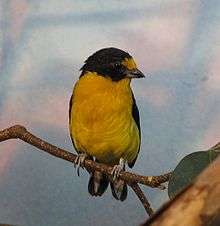Euphonia
| Euphonia | |
|---|---|
 | |
| Violaceous euphonia, Euphonia violacea | |
| Scientific classification | |
| Kingdom: | Animalia |
| Phylum: | Chordata |
| Class: | Aves |
| Order: | Passeriformes |
| Suborder: | Passeri |
| Infraorder: | Passerida |
| Superfamily: | Passeroidea |
| Family: | Fringillidae |
| Subfamily: | Euphoniinae |
| Genus: | Euphonia Desmarest, 1806 |
| Species | |
|
See text. | |
Euphonias are members of the genus Euphonia, a group of Neotropical birds in the finch family. They and the chlorophonias comprise the subfamily Euphoniinae.
Most euphonias are dark metallic blue above and bright yellow below. Many have contrasting pale foreheads and white undertails. Some have light blue patches on the head and/or orangish underparts. They range in overall length from 9 to 11 cm (3.5 to 4.3 in). They eat small fruit and berries particularly mistletoe (Loranthaceae). Some species may also eat some insects.[1]
Euphonias were once considered members of the tanager family, Thraupidae.[2] A molecular phylogenetic study of the finch family Fringillidae published in 2012 included 9 species from the genus Euphonia and a single species from the genus Chlorophonia, the blue-naped chlorophonia. The resulting cladogram showed the blue-naped chlorophonia nested within the Euphonia clade implying that the genus Euphonia is paraphyletic.[3] The name of the genus was introduced by the French zoologist Anselme Gaëtan Desmarest in 1806.[4]
Species list
The genus contains 27 species:[5]
- Jamaican euphonia, Euphonia jamaica
- Plumbeous euphonia, Euphonia plumbea
- Scrub euphonia, Euphonia affinis
- Purple-throated euphonia, Euphonia chlorotica
- Yellow-crowned euphonia, Euphonia luteicapilla
- Trinidad euphonia, Euphonia trinitatis
- Velvet-fronted euphonia, Euphonia concinna
- Orange-crowned euphonia, Euphonia saturata
- Finsch's euphonia, Euphonia finschi
- Violaceous euphonia, Euphonia violacea
- Thick-billed euphonia, Euphonia laniirostris
- Yellow-throated euphonia, Euphonia hirundinacea
- Green-chinned euphonia, Euphonia chalybea
- Elegant euphonia, Euphonia elegantissima
- Antillean euphonia, Euphonia musica
- Golden-rumped euphonia, Euphonia cyanocephala
- Spot-crowned euphonia, Euphonia imitans
- Fulvous-vented euphonia, Euphonia fulvicrissa
- Olive-backed euphonia, Euphonia gouldi
- Bronze-green euphonia, Euphonia mesochrysa
- White-lored euphonia, Euphonia chrysopasta
- White-vented euphonia, Euphonia minuta
- Tawny-capped euphonia, Euphonia anneae
- Orange-bellied euphonia, Euphonia xanthogaster
- Rufous-bellied euphonia, Euphonia rufiventris
- Chestnut-bellied euphonia, Euphonia pectoralis
- Golden-sided euphonia, Euphonia cayennensis
The black-throated euphonia ("Euphonia vittata") is now thought to be a hybrid between the chestnut-bellied euphonia and the orange-bellied euphonia.
References
- ↑ del Hoyo, J.; Elliott, A.; Sargatal, J.; Christie, D.A.; de Juana, E. (eds.). Handbook of the Birds of the World Alive. Lynx Edicions. Retrieved 15 July 2015.(subscription required)
- ↑ Banks, Richard C.; Cicero, Carla; Dunn, Jon L.; Kratter, Andrew W.; Rasmussen, Pamela C.; Remsen, J.V. Jr.; Rising, James D.; Stotz, Douglas F. (2003). "Forty-fourth supplement to the American Ornithologists' Union Check-List of North American Birds". The Auk. 120 (3): 923–931. doi:10.1642/0004-8038(2003)120[0923:FSTTAO]2.0.CO;2.
- ↑ Zuccon, Dario; Prŷs-Jones, Robert; Rasmussen, Pamela C.; Ericson, Per G.P. (2012). "The phylogenetic relationships and generic limits of finches (Fringillidae)" (PDF). Molecular Phylogenetics and Evolution. 62 (2): 581–596. doi:10.1016/j.ympev.2011.10.002.
- ↑ Desmarest, Anselme Gaëtan (1806). Histoire naturelle des tangaras, des manakins et des todiers (in French). Paris: Garnery. p. 35 and plate 27 (pages and plates are not numbered).
- ↑ Gill, Frank; Donsker, David (eds.). "Finches, euphonias". World Bird List Version 5.2. International Ornithologists' Union. Retrieved 5 June 2015.
External links
| Wikimedia Commons has media related to Euphonia. |
- Euphonia videos, photos and sounds on the Internet Bird Collection